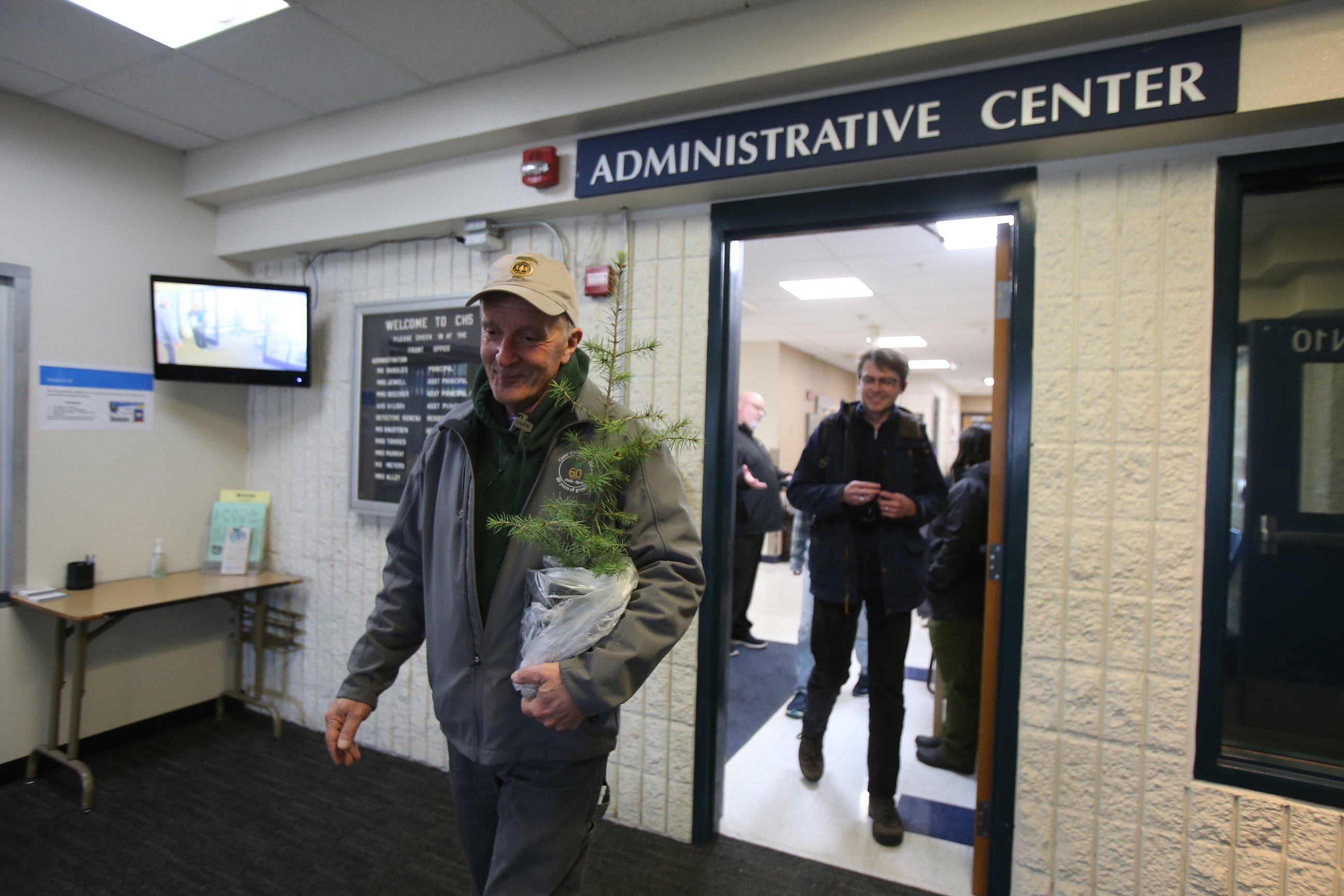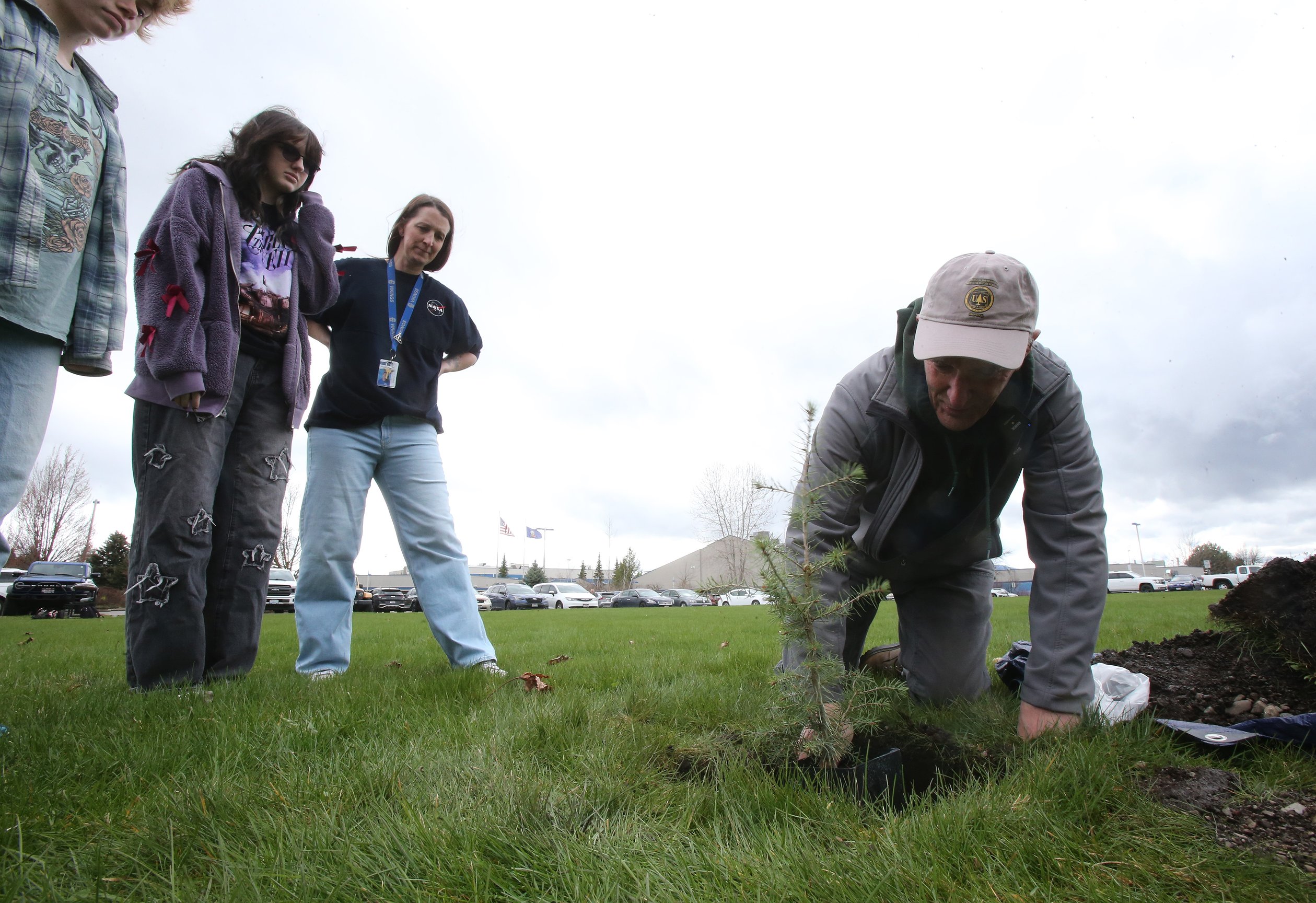Coeur d'Alene High recipient of Douglas fir that went to space
COEUR d'ALENE — Some trees become matchsticks, musical instruments or furniture.
Others are turned into paper and used to make books filled with extraordinary tales of adventure.
A few select trees become space travelers and have exciting stories of their own.
One such NASA Moon Tree was planted Monday afternoon at Coeur d'Alene High School.
The special Southwest Douglas fir was among about 1,000 seeds that orbited the moon in November and December 2022 on the Artemis I mission, which launched a mega moon rocket into space and sent the Orion spacecraft on a 1.4-million-mile journey beyond the moon and back during an uncrewed flight test. This was the first in a series of missions to prepare astronauts for walking the lunar surface and for a long-term presence at the moon to enable future crewed missions to Mars.
The modern Moon Tree program commemorates the Apollo 14 mission that carried the first tree seeds into space.
"One of the astronauts (Stuart Roosa) used to be a smoke jumper before he became an astronaut. The chief of the Forest Service at that time called him up and said, 'Hey, it'd be really nice if you could take some seeds up there in space and bring them back and then we'll grow them and call them Moon Trees,'" said Aram Eramian, who manages the U.S. Forest Service’s Coeur d’Alene Nursery.
Those first seeds — loblolly pine, sycamore, sweetgum, redwood and Douglas fir — went to space in 1971. Fifty years later, NASA contacted the Forest Service to revive the program for the Moon Tree milestone. The seeds from the Artemis I mission included Douglas firs from the Washington coast, sequoias from California, sycamores and sweetgums.
"Not to be outdone, North Idaho sent in a packet of Inland Douglas fir," Eramian said. "I can safely say that Inland Douglas fir is not going to grow on the moon because none of the seeds germinated on the trip. Not that we would grow any seedlings on the moon, but it was a little bit disheartening."
NASA’s Orion spacecraft returned with more than 2,000 tree seedlings sourced in partnership with the Forest Service. Since then, Artemis I Moon Trees have been planted at 236 sites across the U.S. A sycamore was planted at American Falls High School in American Falls in spring 2024. Two other Moon Trees were planted in Spokane and the Spokane Valley in 2024.
"We grow a lot of seedlings all the time, but none of them have gone to the moon," Eramian said. "This is kind of neat. It breaks up the day to grow something like this and be a part of this national event."
Eramian said the Southwest Douglas fir grows at 7,000-foot elevation and will do well in North Idaho.
"We're really pleased that you received one in Coeur d'Alene," Eramian said to science and biology teacher Jennifer Haas, who submitted the Moon Tree application when the program was resurrected.
Senior Madi Graham said she was happy Coeur d'Alene High was selected for the Moon Tree. She and fellow NASA Club member Ellie Staudacher had the honor of planting the tree.
"This project is so special to me because as a little kid I always dreamed of going to space and discovering what lies out there for us," Madi said. "I was so excited to help plant the tree because while it may be small right now, as the years go on it will grow old with me and eventually inspire a new generation of kids who love space as much as I do.
"I feel honored to be able to plant this tree that connects our community to the stars above and will continue to live on for generations and generations," she added.
Haas said it's an amazing and rare opportunity, especially given the program's history.
"We have a team here that studies the Artemis moon mission," Haas said. "To have a piece of it that's been there is incredible."
The Moon Tree will be protected by a small cage and will soon have a proper plaque to tell its unique story.
"I'm just really excited that we get to have something special like this," said sophomore Teddy Gridley, who documented the tree planting for the school's yearbook.
"You don't see every day at other schools a tree that went to the moon," she said.
Info: nssdc.gsfc.nasa.gov
 Aram Eramian, Coeur d'Alene Nursery manager for the U.S. Forest Service, walks out of the front office at Coeur d'Alene High School with a Moon Tree on Monday. The tree, which was planted on the north lawn, was one of about 1,000 seeds to travel to space during the Artemis I mission in 2022 in commemoration of the Moon Tree seeds that went to space during the Apollo 14 mission in 1971.
Aram Eramian, Coeur d'Alene Nursery manager for the U.S. Forest Service, walks out of the front office at Coeur d'Alene High School with a Moon Tree on Monday. The tree, which was planted on the north lawn, was one of about 1,000 seeds to travel to space during the Artemis I mission in 2022 in commemoration of the Moon Tree seeds that went to space during the Apollo 14 mission in 1971.



